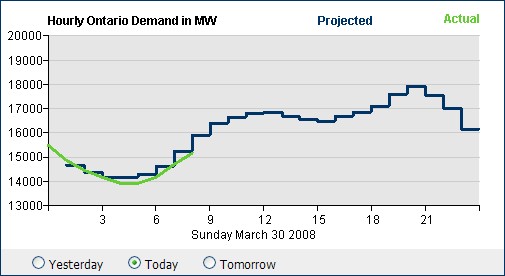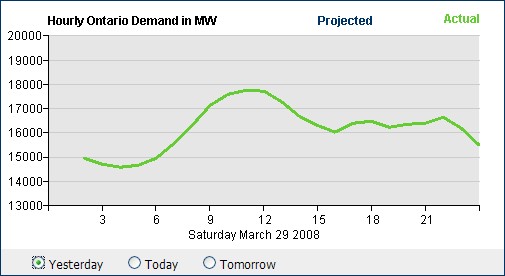I’ve heard a lot of criticism of Earth Hour over the past few days, mainly that it was a token public effort by people who aren’t really committed to any permanent change. Whether that’s true or not can’t be determined from last night’s behaviour alone, although I have read that some local businesses were using this as a test for how they can reduce their energy consumption on a regular basis while still maintaining safety standards.
In looking at last night’s behaviour specifically, consider the expected power demand curve for today (Sunday) in Ontario: pretty low at 8am when I grabbed these from the Ontario Wholesale Electricity Demand and Price Information site, expected to climb before noon as people start to make lunch and do laundry, then increase to a peak around 8pm when the sun has just set, the dishwasher is on after dinner, and people settle down to the TV or computer for a couple of hours. The green curve is actual demand, the darker step graph is the projected demand, and these guys are usually pretty accurate.
Now here’s what happened yesterday, which included Earth Hour at 8pm (20 on the horizontal axis):
I wished that I had captured the projected demand curve earlier in the day for comparison, but I suspect that the expected curve would have been much like today’s graph shown at the top. We see a higher demand midday than today, due to more businesses open on Saturday than Sunday, but then an interesting phenomenon: long before Earth Hour starts at 8pm, power consumption drops off, and stays well below the midday peak for the remainder of the evening, even after Earth Hour completed at 9pm.
So what’s the story here? This is only my hypothesis, but I think that businesses and individuals started lowering their power consumption much earlier in the day (around 3pm, when the usual evening demand would normally start to build) and maintained the lower power levels longer than the designated hour (until 10:30, when the usual evening demand would normally start to drop off) because of the awareness that Earth Hour raised; in other words, Earth Hour actually had an impact seven to eight times longer than planned.
During the actual hour of 8-9pm, a lot of us were sitting around in the dark or out on the street gawking at the lack of lights in some of the buildings, but what were we doing all afternoon until 8pm, and after 9pm, that also made a difference? Obviously, we were all going about our normal Saturday lives, but somehow using much less energy than usual. That gives me hope that this isn’t just a placebo, and we can reduce energy consumption if we take yesterday’s lessons to heart.



Sandy,
Interesting observation. I just came back from Australia, and Earth Hour has been advertised front and center there, while you’d have to look out for heavy advertisements here in New York. But on a related note, I attended an excellent talk by Massoud Amin from the University of Minnesota a few weeks ago, and he presented a concept called “Prices to Devices”. The basic idea is that as long as consumers have to make manual decisions about energy consumption you will not shift the demand curves significantly. But if you can introduce flexible pricing, and distribute the pricing information to the consumption units (dishwashers, A/C units etc.) then sufficiently intelligent devices will be able to schedule themselves based on the market rates of electricity. ESRI published a thorough whitepaper on this, it can be found here.
Best
Michael